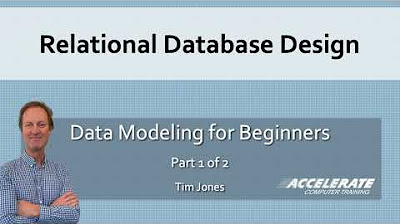[BGD02B-ID] Entity Relationship (ER) Modelling
Summary
TLDRThis beginner's guide to database design focuses on entity-relationship (ER) modeling, a crucial technique for organizing data within an organization. It introduces the key concepts of entity types, represented by boxes, which group objects with similar properties like students or products. Relationships, shown as diamonds or rectangles, illustrate how entities interact, such as the connection between employees and branches in a company. Attributes describe the properties of entities, like a student's name or a branch's address. Lastly, constraints define the limits of these relationships, like an employee working in only one branch, exemplifying the one-to-many relationship. The tutorial aims to ensure a consistent understanding of data across different perspectives within an organization.
Takeaways
- 📚 The video is a beginner's guide to database design, focusing on entity-relationship modeling.
- 🌐 Entity-relationship modeling is used to provide a clear picture of the data used within an organization.
- 👥 Data can be viewed from different perspectives or departments within an organization.
- 📊 Modeling ensures that different viewers get the same understanding of the data, avoiding confusion or misinterpretation.
- 📦 The script introduces several notations used in ER modeling to represent data.
- 🏢 'Entity type' is a notation representing a group of objects with the same properties, such as 'Student' or 'Product'.
- 🔗 'Relationship' shows the connection between entities, like an employee working in a branch of an organization.
- 📝 'Attributes' are properties of entities, such as a student's name, address, and phone number.
- 🔢 'Constraints' define the type of connection between entities, like one-to-many relationships.
- 👥 An example of a constraint is that an employee can only work in one branch, while a branch can have many employees.
- 👋 The video concludes with a brief introduction to ER modeling and a thank you note to the viewers.
Q & A
What is the main topic discussed in the beginner guide to database design?
-The main topic discussed is entity-relationship modeling (ER modeling) in the context of database design.
Why is a clear data model important for an organization?
-A clear data model is important for ensuring that different people or departments within an organization have the same understanding of the data being used, preventing confusion or misunderstandings.
What are the common notations used in ER modeling?
-Common notations used in ER modeling include entity types (represented by rectangles), relationships (represented by diamonds or ovals with lines connecting entities), and attributes (properties of entities).
What is an entity type in ER modeling?
-An entity type is a collection of objects or things that share the same properties, such as 'Students' or 'Products', represented by a rectangle in ER diagrams.
Can you give an example of an entity type mentioned in the script?
-Yes, an example of an entity type is 'Students', where each student has attributes like name, address, and phone number.
What is a relationship in ER modeling?
-A relationship in ER modeling represents the association between different entities, such as the connection between 'Employees' and 'Branches' within an organization.
How is a relationship visually represented in an ER diagram?
-A relationship is visually represented by a diamond or oval shape connected to the related entities with lines.
What are attributes in the context of ER modeling?
-Attributes are the properties of entities, such as the name, address, and phone number of a student, or the branch name, location, and phone number of a branch.
What is a constraint in ER modeling?
-A constraint in ER modeling refers to the limitations or rules that define how entities can be related to each other, such as an employee working in only one branch (one-to-one) or many employees working in one branch (one-to-many).
How is the one-to-many relationship represented in an ER diagram?
-The one-to-many relationship is represented by a line connecting an entity (one) to another entity (many), indicating that one of the former can be associated with many of the latter.
What is the purpose of using constraints in ER modeling?
-The purpose of constraints in ER modeling is to define the rules that govern the relationships between entities, ensuring data integrity and accuracy within the database.
Outlines

Esta sección está disponible solo para usuarios con suscripción. Por favor, mejora tu plan para acceder a esta parte.
Mejorar ahoraMindmap

Esta sección está disponible solo para usuarios con suscripción. Por favor, mejora tu plan para acceder a esta parte.
Mejorar ahoraKeywords

Esta sección está disponible solo para usuarios con suscripción. Por favor, mejora tu plan para acceder a esta parte.
Mejorar ahoraHighlights

Esta sección está disponible solo para usuarios con suscripción. Por favor, mejora tu plan para acceder a esta parte.
Mejorar ahoraTranscripts

Esta sección está disponible solo para usuarios con suscripción. Por favor, mejora tu plan para acceder a esta parte.
Mejorar ahoraVer Más Videos Relacionados
5.0 / 5 (0 votes)






